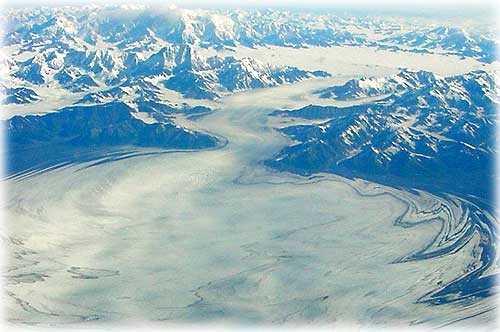 August 13, 2003
 Photo by Dick Kauffman - August 2003
The researchers now know why some cut so fast and others seem to be inert and that glacial erosion is controlled by the relationships of the ground beneath the glacier, the rubble pile and the glacier itself. "If you imagine a glacier as sandpaper, grinding away at the land, eventually the rubble it produces gets in the way and must be removed," says Alley. Streams of water that flow beneath the glaciers and come out the toe, flush out the boulders, rocks and gravel. During erosion, glaciers dig themselves into a hole with sediment building up in front so that the upper and lower surfaces of glaciers slope in opposite directions. Alley, working with D. E. Lawson, research physical scientist, Cold Regions Research and Engineering Laboratory; G.J. Larson, professor of geosciences, Michigan State University; E.B. Evenson, professor of geosciences, Lehigh University, and G. S. Baker, professor of geosciences, University of Buffalo, compiled various data on glaciers to establish that, eventually, the angle between the glacier's toe and the sediment pile becomes so steep, that the streams no longer flow and the glacier no longer erodes the earth beneath. The water beneath a glacier is under high pressure from tons of ice above. High pressure lowers the melting temperature so the water remains liquid below 32 degrees Fahrenheit. As the high pressure squeezes the water out from under the weight of the ice, the freezing temperature rises to 32 degrees, and the water must either warm or freeze. Usually, friction in the flowing water warms it, but when the angle becomes too steep, the water flow is slowed, there is not enough friction and some of the water freezes, plugging the channels. The water then spreads out over the bed of the glacier, flows very slowly and is not able to carry rubble away so that the glacier can erode more. "We thus hypothesize that the beds of highly erosive glaciers tend to evolve to an equilibrium angle close to but slightly steeper than the supercooling threshold," the researchers report in today's (Aug. 14) issue of Nature. At this point the glacier stops eroding, and according to Alley, this is the place where glaciers like to be, where they are at equilibrium. However, they cannot stay there forever because outside forces shape and change the glaciers. IF warming melts the toe of the glacier so that the surface steepens, water will be pushed out from under the glacier faster, making more heat and the glacier will resume eroding. "Step into the stream in front of that glacier and you would get your ankles battered because boulders are coming out of the glacier with the water," says Alley. "But, if the surface of the glacier becomes flatter, water beneath will be pushed out slowly, more freezing will occur and no big rocks come out from the front of the glacier." Understanding the way that glaciers erode mountains and achieve a steady state existence is important for those who study how mountains build and erode, especially because climate change can alter the rhythm of this equilibrium. "Most glaciers are moving
too much sediment at the moment because of the melting of the
glaciers," says Alley.
Photo Credit:
Source of News:
|